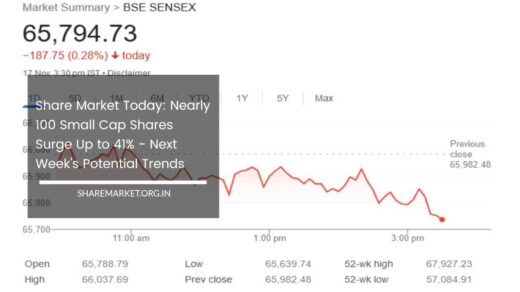Sensex Down 588 Points, Nifty at 24,039; Tomorrow Nifty Prediction
Markets End Lower for Second Day – Key Trends to Watch Ahead of April 29 Trading
The Indian stock market ended in negative territory for the second consecutive session on April 25, amid widespread selling pressure across sectors—especially in small-cap and mid-cap stocks.
A combination of profit booking, weak global cues, and rising geopolitical concerns kept investor sentiment cautious.
As we move closer to the next trading session on Monday, April 29, let’s take a deeper look at the market’s performance, sectoral trends, expert analysis, and what investors should be watching for in the week ahead.
Market Summary – April 25
Indian equity benchmarks declined sharply, erasing early gains and closing near the day’s lows. The BSE Sensex slipped 588.90 points, or 0.74%, to close at 79,212.53, while the Nifty 50 fell 207.35 points, or 0.86%, to end at 24,039.35.
Market breadth remained heavily skewed in favor of declines:
- 682 stocks advanced
- 3,138 stocks declined
- 115 stocks remained unchanged
The broader market underperformed significantly, with both the Nifty Midcap 100 and Nifty Smallcap 100 indices falling by 2.5%.
This steep decline highlights growing investor concerns over valuation in the broader market, especially in smaller, more speculative stocks.
Sectoral Snapshot – IT Shines Amid Broad-Based Sell-Off
It was a sea of red across sectors, with only IT stocks managing to close in the green. Other sectors, including:
- Media
- Metals
- Public Sector Banks
- Telecom
- Power
- Oil & Gas
- Real Estate
…fell sharply, registering losses in the range of 2–3%. Weak global commodity prices and cautious investor sentiment contributed to the underperformance in sectors like metals and realty.
On the other hand, the IT sector saw selective buying interest. With global tech stocks showing signs of resilience and expectations of margin stability in the upcoming quarters, investors seemed to favor defensiveness amid the sell-off.
Top Nifty Performers and Laggards
Top Gainers
- SBI Life Insurance
- Infosys
- TCS
- Tech Mahindra
- IndusInd Bank
These stocks managed to withstand broader selling pressure, buoyed by strong fundamentals and stable outlooks.
Top Losers
- Axis Bank
- Adani Enterprises
- Shriram Finance
- Adani Ports
- Trent
These counters witnessed significant profit booking, particularly in financials and infrastructure-related stocks, which had seen strong rallies in recent weeks.
What’s Moving the Market?
1. FII Inflows Provide Underlying Support
A major positive supporting market sentiment is the continued buying by foreign institutional investors (FIIs).
According to exchange data, FIIs pumped in over ₹29,513 crore last week, suggesting confidence in India’s economic fundamentals even amid global uncertainty.
The strengthening US dollar and relatively stretched valuations in US equities are also driving global investors to diversify into emerging markets like India, where long-term growth prospects remain strong.
2. Potential US-India Trade Pact in Focus
Another encouraging signal came from a recent statement by US Treasury Secretary Scott Bessant, who indicated that India could be the first country to enter into a bilateral trade agreement with the United States.
As the US attempts to diversify its trade relationships beyond China, India is increasingly seen as a reliable and fast-growing partner.
Such developments could pave the way for increased foreign direct investment (FDI), improved trade flows, and broader economic cooperation—all of which bode well for the Indian economy and equity markets.
3. Geopolitical Risks and Volatility
Despite these positives, markets remain on edge due to geopolitical tensions and recent terrorist attacks, which could disrupt global supply chains and investor risk appetite.
This geopolitical overhang has introduced a layer of uncertainty, particularly in sectors sensitive to global sentiment like metals and oil & gas.
Valuation Check – Is the Market Getting Attractive?
The recent correction has cooled off overheated valuations, especially in the mid and small-cap space. However, according to Rajesh Palviya of Axis Securities, the market still hasn’t entered the “deep value” zone.
“Valuations are still not very attractive, but investors are focusing on quality names with strong earnings visibility,” Palviya said.
This selective buying approach indicates that while investors remain cautious, they are still willing to deploy capital in fundamentally strong companies.
Technical Outlook – Key Levels to Watch
On the technical front, the Nifty remains in an overall uptrend, despite the short-term pullback. Sameet Chavan, Chief Analyst at Angel One, noted that the index has successfully breached the swing high of 23,900 from the February–March period and is trading above its 200-day Simple Moving Average (SMA) of 24,000.
“This breakout confirms a bullish structure. The 24,000 mark, which acted as resistance earlier, is now expected to serve as strong support,” Chavan added.
He identifies the following key resistance levels:
- First Resistance: 24,400
- Second Resistance: 24,550 – the 61.8% Fibonacci retracement level of the decline from the all-time high
Chavan recommends maintaining a buy-on-dips approach, particularly as long as Nifty holds above the 24,000 support zone.
What to Expect on April 29
As we approach the April 29 session, here are the key triggers to monitor:
1. Global Market Trends
Any overnight cues from US markets, crude oil prices, and geopolitical news could influence opening sentiment.
2. FII and DII Activity
The direction of institutional flows remains a critical driver. Continued FII inflows may help cap downside in large-cap stocks.
3. Corporate Earnings Season
As Q4 earnings continue to trickle in, stock-specific moves will remain sharp. Positive surprises may offer opportunities even in a subdued market.
4. Technical Support at 24,000
A sustained hold above this level could attract fresh buying. Conversely, a breakdown below this level may lead to increased volatility.
Final Thoughts
The market is currently at an important juncture, trying to balance strong macroeconomic fundamentals with external headwinds.
While large-cap stocks continue to draw interest, the sharp fall in mid and small caps suggests caution is warranted. Investors should focus on companies with robust earnings, stable management, and clear visibility.
Short-term volatility may persist, but the broader trend remains constructive—especially if institutional flows stay positive and global risks are contained.


















